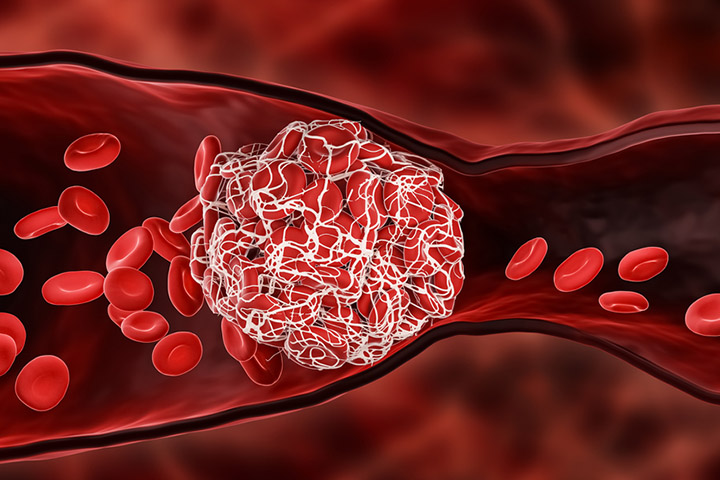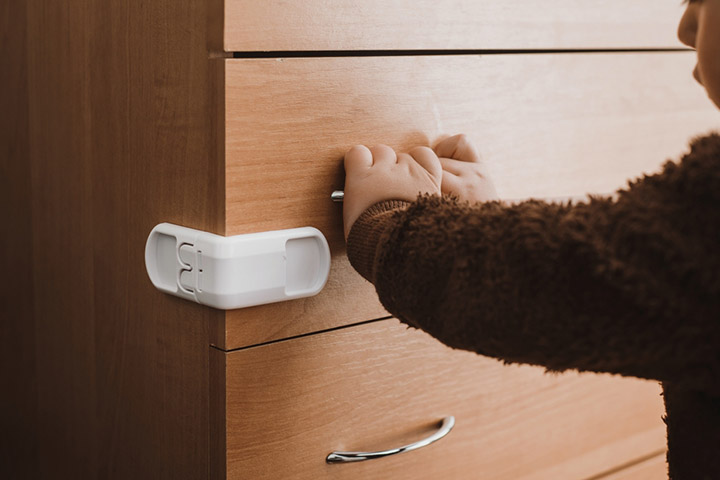Babies have softer skin, and hence they bruise easily, especially when they begin to crawl or walk. Bruises on infants can occur if they hit or bump their bodies against a wall or any object. This may damage blood vessels and lead the blood to clot under the skin. Most bruises in babies are not concerning, but they can be due to underlying morbidity or other problems, as well.
It is good to be aware of the reasons for bruising to differentiate between harmless and harmful ones. Read on to know more about bruises in babies, including their causes and when to worry about them.
Is It Normal For A Baby To Bruise?
It is common for newborns to have bruises on their head and body right after vaginal birth (1). The physical stress during childbirth is the reason behind the bruises, which usually vanish within a few days.
Some infants delivered through prolonged or stressful labor may tend to have dark bruises or contusions, usually around the neck, head, and shoulder. In most cases, these bruises do not cause any harm or pain and fade away within a few days. The doctor will examine the newborn for bruises to rule out any serious cause.
Older babies and toddlers could develop bruises when they begin to crawl or take their first steps (2). Parents may observe bruises on the baby’s forehead, elbows, knees, shins, or palms. Dressing the baby appropriately may avoid bruises due to movement and friction. As the baby gets adept at crawling or walking, you are less likely to see bruises.
What Are The Signs Of Bruising In Babies?
The most common signs of bruising in children are discoloration or darkened areas of skin from minor trauma. Bruises typically occur on bony areas like the shins but can appear on the back, stomach, or back of the arm, which warrants medical attention. Other warning signs include worsening bruises after a head injury, sudden unexplained bruising, and bruises that do not begin fading within 3-5 days.
While some bruising is normal, excessive or unusual bruising could indicate an underlying issue like anemia, vitamin deficiency, blood clotting disorder, or rarely even cancer. If bruises do not heal properly or are accompanied by other symptoms like nosebleeds or bleeding gums, testing by a pediatrician may be required. Parents should monitor bruising patterns but allow normal activity, only worrying about persistent, worsening, or unexplained bruises (3).
What Causes Bruises In Babies?
Childbirth and friction while crawling or walking are the common causes for normal bruising among babies. However, there could be other serious underlying causes. Bruises could be a sign of concern if they appear around the eyes or ears, soft tissue area in the cheeks, abdomen, buttocks, or inside the mouth (4).
The following conditions or situations could lead to serious painful bruising in babies.
- Falls and injuries:When babies start crawling or walking, chances are they might fall and develop a deep bruise on their head, chin, knee, or forehead. Depending on the size of the bruise, parents may determine the extent of the injury or wound and what type of medical help is required.
Besides the reasons mentioned above, babies can develop rashes or bruises for various causes. Michelle, a mother of two, shares her experience of finding a bruise-like rash on her daughter’s tongue, “When I checked on her she yawned and I noticed a mark on her tongue! She had a legitimate bruise on her tongue! She doesn’t even have any teeth yet! ‘The mark’ faded as well, by this morning it was only a slight discoloration. It seems as though she clamped her tongue between her gums and bruised it. This apparently is very common though I don’t recall it ever happening with big brother (her older child) (i).”
- Child abuse: According to the child maltreatment statistics published by the U.S. Department of Health & Human Services, 28.6% of children under the age of two years are susceptible child abuse victims, of which 15.2% are under the age of one. Extensive bruising or the appearance of unexplained scratches and bruises on babies may indicate child abuse. Bruises on upper arms, neck, ears, and buttocks in specific shapes, like a large bite mark, cigarette burn or belt mark, can be signs of child abuse (5).
- Vitamin K deficiency: Vitamin K is important for blood clotting. Babies are usually born with low amounts of vitamin K, leading to health problems when not supplemented. Babies may experience bruising or bleeding issues when they experience sustained vitamin K deficiency (6).
- Von Willebrand disease: Frequent bruising that occurs easily may also be indicative of Von Willebrand disease, a genetic disorder where the blood does not clot properly (7).
- Idiopathic thrombocytopenic purpura (ITP): It is an autoimmune disorder that causes the breakdown of platelets, leading to low platelet count in the body. It is usually thought to be triggered by a recent viral infection, after which young children develop large bruises and small purple dots under the skin, known as petechiae (8).
- Henoch-Schonlein purpura (HSP):HSP is a type of immune disorder that can cause abdominal pain,bloody stools, joint pain and a distinctive rash that look like bruises (purpura). It may appear on the baby’s arms, legs, or buttocks, commonly in older babies and toddlers (9).
- Hemophilia A and B: This genetic condition causes a defective clotting mechanism of the blood. Some of its symptoms are easy bruising and excessive bleeding after cuts (10). Minor cases may go undiagnosed until toddlerhood, while severe hemophilia may be diagnosed within infancy.
- Leukemia: It is a type of blood cancer that can cause bruises. Children with leukemia will also have low platelet count, low red blood cell count, fever, and unexplained weight loss.
- Disseminated intravascular coagulation: It is a rare bleeding condition that can cause bruising, bleeding, and uncontrolled blood clotting. Newborns may develop it due to birth injuries or early problems, such as asphyxia, sepsis, and respiratory distress.
When To See A Doctor?
Bruises that appear immediately after birth will be examined by the doctor to rule out any serious cause. You must see a doctor if you notice any bruising within the first three months of the baby’s life. You must also see a doctor in the following scenarios (11).
- Bruises occur after the baby experienced a severe fall or injury.
- Bruises in immobile infants who do not crawl yet.
- Bruises present in unusual places, such as the buttocks, behind the ears, and around the eyes.
- Multiple bruises, signs of inflammation, and pink spots (petechiae) on the baby’s body for no explained reason.
- Any existing bruise which takes several weeks to heal.
- Baby displays other signs of a possible underlying problem, such as frequent bleeding, often from the nose, unexplained weight loss, frequent vomiting, loss of appetite, lethargy, or poor weight gain.
It is also good to consult a doctor if you have a family history of genetic problems or if the baby’s sibling has an existing genetic problem. Bruises may often be mistaken for Mongolian spots, which are harmless bluish-black birthmarks. They are not accompanied by other anomalies and occur even in healthy babies.
How To Treat Your Baby’s Bruises?
If your baby develops bruises or soreness due to crawling or walking, you may dress them in clothes that cover their elbows and knees. You may also place them on softer surfaces, such as a carpet, for crawling. Bruises due to friction do not require any specialized care and get better when the friction is reduced with adequate insulation.
Bruises due to serious causes could require treatment relevant to that condition. The treatment modalities and their intensity and duration will vary based on the underlying cause. For instance, bruises due to injuries could require basic first aid at an outpatient clinic, while bruises due to a genetic condition could require hospitalization. Discuss the potential treatment options and long-term outcomes with your baby’s pediatrician.
How To Prevent Bruises In Babies?
Bruises due to crawling and walking can be prevented by proper insulation. You may also baby-proof your house to reduce the risk of bruising due to sharp objects. A few ways to baby-proof your house is restricting access to furniture and placing a safety gate on the stairway. You must also not leave the baby unattended once they begin to crawl or walk.
Serious bruising can also be prevented with other appropriate measures. For instance, you may prevent the risk of child abuse-related bruising by leaving the baby only in the care of trusted people. Vitamin K deficiency-related bruising can be prevented by providing appropriate supplementation after discussion with a doctor.
If you have a family history of bleeding-related genetic conditions, stay alert to any early signs of it, such as unexplained bleeding and bruising. You may also discuss the appropriate preventive care with a healthcare provider or a specialist in genetic disease.
Bruises on infants are common right after vaginal birth or while learning to crawl or walk. These bruises are usually benign and self-heal within a few days or weeks. However, an infant or baby can also get severe bruises due to child abuse, vitamin K deficiency, or underlying health issues. Thus, pediatric consultation is necessary if you notice any bruises on your baby in the first three months after birth. Further, baby-proofing your home is one of the most effective ways to prevent bruises caused by injuries and accidental falls.
Key Pointers
- When a baby’s blood vessels are injured, blood clots form beneath the skin, resulting in bruises. They are usually caused by birth, crawling, or walking.
- However, some severe causes of bruises in babies are injuries, vitamin K deficiency, Von Willebrand disease, leukemia, etc.
- If babies frequently bruise themselves while crawling or walking, provide them with proper insulation and make your house baby-proof.















